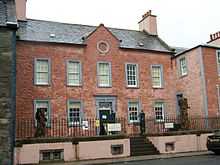Broughton House
Coordinates: 54°50′13″N 4°3′16″W / 54.83694°N 4.05444°W

Broughton House is an 18th-century town house standing at No 12,[1] the High Street, Kirkcudbright, Scotland. It was the home of Scots impressionist artist E. A. Hornel between 1901 and his death in 1933.[2][3]
Built in 1734, the house is actually three combined. Alexander Murray, Provost of Kirkcudbright and MP, bought the properties at No. 12 and No. 10 in 1740 and had them remodelled as one. The Murray family sold it in 1756, after which it was occupied by various wealthy locals, including the 5th Earl of Selkirk.[3]
Hornel residence
Hornel bought the property in 1901, from the proceeds of the sale of 30 Japanese paintings, executed during a 16-month stay in Japan between 1893 and 1894. He lived in the house for the rest of his life.[2] Hornel hired his friend, the Glasgow-based architect John Keppie, to design and build the Studio for him, then had the Gallery added in 1910.[3]
Throughout his life Hornel had been looked after by his sister, Elizabeth. On his death he left the life-rent of the house to her, but wished that Broughton House
- be preserved as a public art gallery for the benefit of the people of the Stewartry and visitors thereto.
National Trust

On Elizabeth's death in 1950 the National Trust for Scotland took over his bequest and now manage his estate.[4]
Library
As well as the many artworks on show, the house contains a large reference library of some 15,000[4] books and manuscripts collected by Hornel. These include many rare manuscripts, of which the 2,500 volume Burns collection[5] is one of the largest such collections in the world.[6] Other rares works by Thomas Carlyle and J.M.Barrie, among others make the collection one of the most significant in Scotland.[5]
Gardens
The gardens, which back onto the River Dee, still contain many features designed by Hornel[7] in the Japanese style.[1][8] It remains a curious and colourful mixture of Eastern and Western horticulture and sculpture[6] spread over the 1 acre (0.40 hectares) site in a series of compartments.[4]
References
- ↑ 1.0 1.1 Winn, C. (2007) I Never Knew That about Scotland page 136 Random House. ISBN 0091910242 Retrieved February 2015
- ↑ 2.0 2.1 Checkland, O. (2003) Japan and Britain After 1859: Creating Cultural Bridges page 148 Routledge. ISBN 1135786194 Retrieved February 2015
- ↑ 3.0 3.1 3.2 National Trust for Scotland history of Broughton House. Retrieved February 2015
- ↑ 4.0 4.1 4.2 Parks and Gardens Broughton House Retrieved February 2015
- ↑ 5.0 5.1 Sawyers, J.S. (1999) Maverick Guide to Scotland page 130 Pelican Publishing. ISBN 1455608661 Retrieved February 2015
- ↑ 6.0 6.1 National Trust for Scotland Main entry. Retrieved February 2015
- ↑ Seeni (2012) Kelsey page 3 Author House. ISBN 1477227040 Retrieved February 2015
- ↑ Prince, D. (2009) Frommer's Scotland (11th Ed.) page 179 John Wiley & Sons ISBN 0470588780 Retrieved February 2015